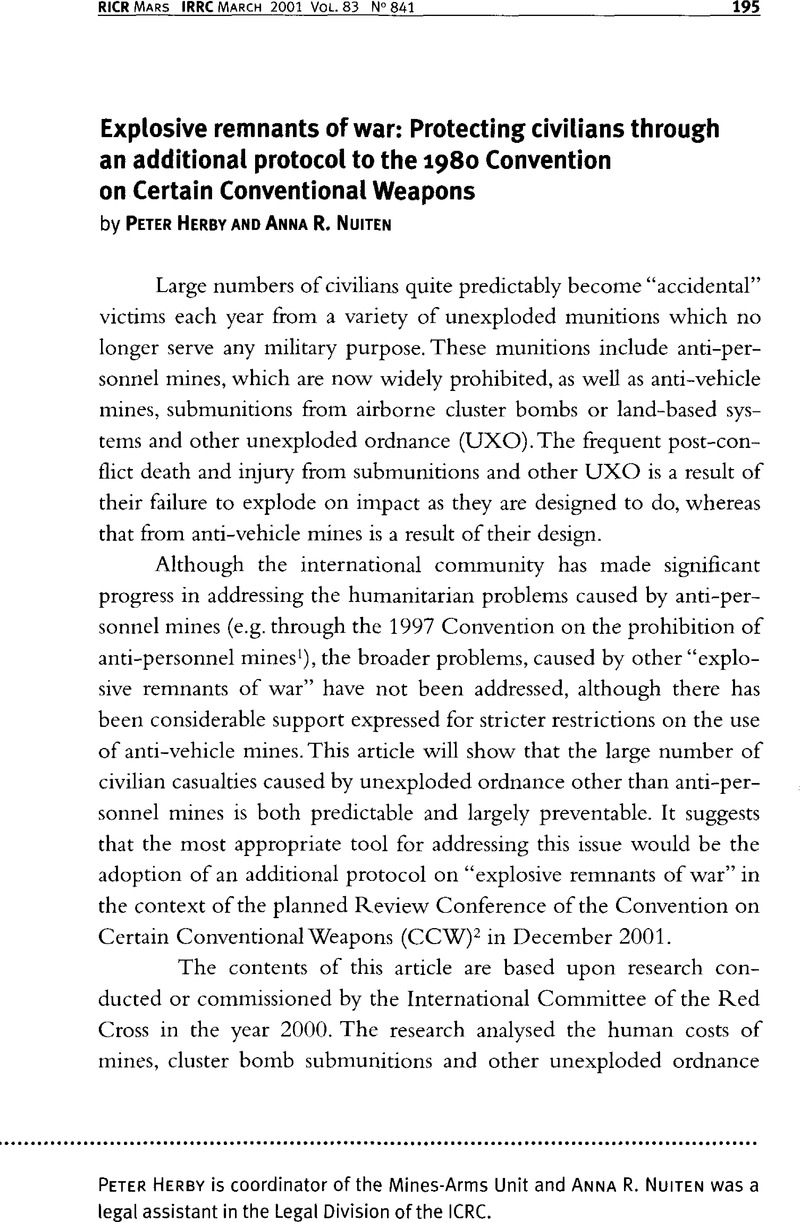Published online by Cambridge University Press: 19 April 2010

1 Convention on the Prohibition of the Use, Stockpiling, Production and Transfer of Anti-Personnel Mines and on their Destruction, Oslo, 18 September 1997.
2 Convention on Prohibitions or Restrictions on the Use of Certain Conventional Weapons Which May be Deemed to be Excessively Injurious or to Have Indiscriminate Effects. Geneva, 10 October 1980.
3 Protocol on Prohibitions or Restrictions on the Use of Mines, Booby-Traps and Other Devices (Protocol II). Geneva, 10 October 1980. Protocol on Prohibitions or Restrictions on the Use of Mines, Booby-Traps and Other Devices as amended on 3 May 1996 (Protocol II to the 1980 Convention as amended on 3 May 1996).
4 Prokosch, Eric, The technology of killing, A military and political history of antipersonnel weapons, London, 1995, p. 114.Google Scholar
5 Ibid.
6 See Colin King, Associates (UXO consultants), referring to talks with B. Lark, former technical adviser to UXO Laos, and further stating that this is a conservative estimate based on the UXO Laos post-conflict impact survey, which states that “up to 30% of the more than 2 million tons of ordnance dropped on Laos failed to explode”.
7 King states that these figures are based on a national survey conducted by Handicap International in 1997.
8 Lao National UXO Programme (UXO Laos), fax containing answers to a questionnaire sent out by the ICRC, Vientiane, 18 May 2000, p. 3.
9 NATO dropped cluster munitions, document presented by NATO to the UN Mine Action Coordination Centre (UNMACC) in Pristina/Prishtine, undated [1999]. See also Mine Action Coordination Centre Compre hensive Update and Plan for the Year 2000, Update as of 5 November 1999, UNMACC, Pristina/Prishtine, November 1999.
10 Based on ICRC talks with a KFOR explosive ordnance disposal specialist, 10 February 2000. This figure is also used formally in KFOR Mine Awareness Briefings.
11 Information provided by Dr. David Meddings, Epidemiologist, Unit of the Chief Medical Officer, ICRC. The 95% confidence interval is (2.3,10.3).
12 The more comprehensive UNMACC data also show that among the 492 casualties from UXO reported to its database from June 1999 through May 2000, cluster bomblets and anti-personnel mines were the leading cause of death and injury – with similar numbers of casualties resulting from each. “Other UXO”, some of which may in fact be cluster bomblets or anti-personnel mines, represent a significant proportion (27% to 35%) of casualties.
13 Information provided by Dr. David Meddings, Epidemiologist, Unit of the Chief Medical Officer, ICRC
14 Westing, Arthur (ed.), Explosive remnants of war: mitigating the environmental effects, Publication of SIPRI & UNEP, Taylor & Francis, London, 1985.Google Scholar
15 Protocol on Prohibitions or Restrictions on the Use of Incendiary Weapons (Protocol III). Geneva, 10 October 1980.
16 Sweden, Egypt, Mexico, Norway, Sudan, Switzerland and Yugoslavia.
17 Algeria, Austria, Egypt, Lebanon, Mali, Mauritania, Mexico, Norway, Sudan, Sweden, Switzerland, Venezuela and Yugoslavia.
18 CDDH/IV/201, Article II (Anti-personnel fragmentation weapons).
19 The report, prepared by a group of eight international experts, forms part of UN General Assembly Doc. A/38/383 (19 October 1983), pp. 6–28.
20 Ibid
21 Including all European Union States, Argentina, Bulgaria, Canada, Cambodia, China, Hungary, New Zealand, Mexico, Norway. Peru, South Africa, Switzerland and the United States.